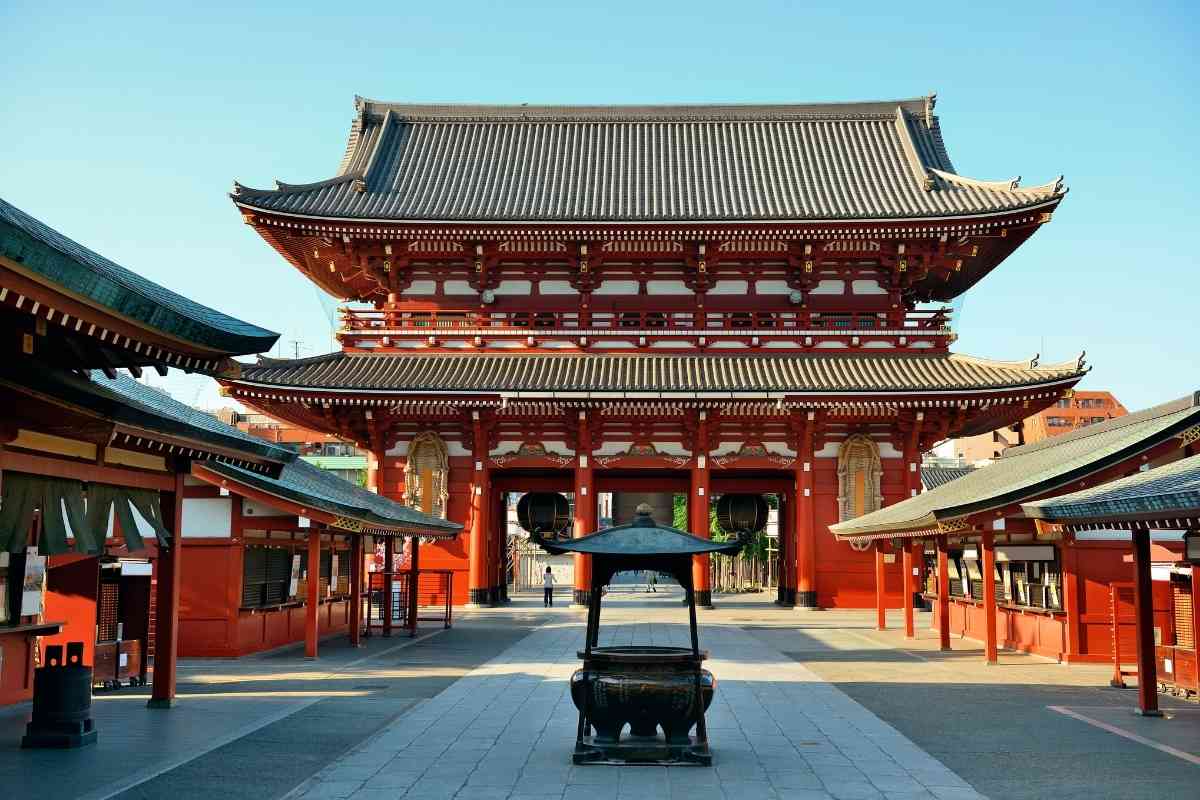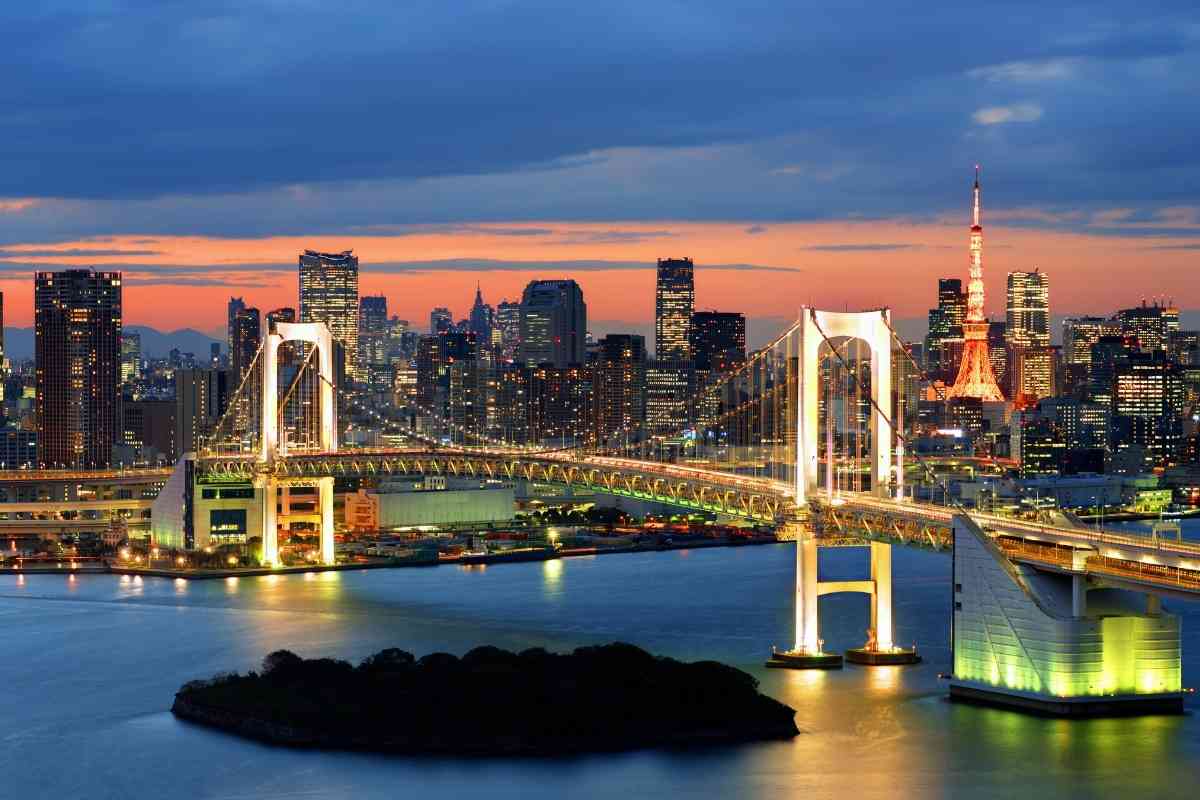9 Reasons Why Japan Is Worth Visiting
Japan is a spellbinding country that most travelers fall in love with the second they arrive.
Its contrasting landscape of towering skyscrapers, ancient temples, and monstrous volcanos makes it one of the most diverse places in the world.
Why is Japan such a popular travel destination?
Travelers love visiting Japan for so many reasons, including the rich history and architecture, to see one of the world’s most technologically advanced cities, the gorgeous natural beauty, not to mention the food and the shopping.
There are numerous reasons why Japan is a great destination for tourists.
Between the rich history, vibrant culture, and beautiful landscapes, Japan has something to entice every type of traveler.
Its Awe-Inspiring Temples

Japan is home to over 80,000 temples.
And while you won’t be able to check them all off your list, it’s still worth visiting a few during your trip.
From the manicured gardens and koi ponds to the elaborate shrines and worshiping halls, you’ll immediately feel at peace once you enter.
Most temples and monasteries in Japan are Buddhist.
These are marked by Buddhist statues and large incense burners for prayers.
On the other hand, shrines are almost exclusively Shinto.
Shinto shrines traditionally have a large red gate and a water basin for washing your hands.
The Izumo-taisha shrine in Izumo is one of the oldest Shinto shrines in the country.
The best time to visit is in the middle of May when you can celebrate two festivals in the same week – the Imperial Festival and the Grand Festival.
The Todai-ji Temple in Nara dates back more than 1250 years and is the largest wooden structure in the world.
It also contains the largest Buddha statue in Japan, measuring almost 50-feet in height.
However, you don’t have to visit the countryside to see beautiful temples and shrines.
In Tokyo, you can visit the Edo-period Kanda Shrine, the royal Meiji Shrine, or the grand Sensoji Temple.
Its Efficient Public Transportation
Even if you don’t speak or read a word of Japanese, you can still easily get around the country using public transportation.
Not only is public transportation fast and reliable, but it’s also known for being energy efficient.
Railway is the most common way to travel between cities.
The shinkansen, or high-speed bullet train, runs all over Japan.
This makes it easy to visit Tokyo, Kyoto, Osaka, and even the islands of Kyushu and Hokkaido.
Besides being punctual (the average delay is just 6 seconds), the shinkansen is incredibly safe.
In over 50 years of operation, there have been no accident-related deaths.
In big cities, rail transport is also the most popular form of travel.
In Tokyo, inner-city trains come every few minutes, which means you can easily get from one neighborhood to another in a matter of minutes.
However, cars can get very crowded, especially during rush hour.
Japan also has a fast and efficient bus network.
Taking the bus is also cheaper than taxis and subways, making this a budget-friendly option for travelers and commuters.
Buses mainly travel around the city, although some lines can take you to more rural areas of the country.
Highway buses can also be used for long-distance travel.
Many of them have bathrooms, WIFI, and seats with privacy curtains.
Its Cultural Festivals

Planning your trip around one of Japan’s numerous festivals (matsuri) is a great way to experience Japanese culture.
Many festivals are celebrated nationally, although some prefectures and cities also host their own local events.
There are three main festivals that take place around the country – Kanda Matsuri in Tokyo, Tenjin Matsuri in Osaka, and Gion Matsuri in Kyoto.
In addition to colorful parades and lively street celebrations with food and dancing, you’ll also be able to see live fireworks displays at night.
Nebuta Masturi is one of Japan’s most beautiful celebrations.
Every year in August, a parade of massive, illuminated paper lanterns float down the streets of Aomori.
These floats can depict warriors, celebrities, animals, and even Gods.
You can dress up in traditional haneto costumes and watch the floats (which are accompanied by taiko drummers and dancers).
If you’re visiting in winter, then the Sapporo Yuki Matsuri is a must.
During this time, larger-than-life snow sculptures and carved iced figurines are put on display.
You can also participate in other winter activities, including snowball fighting, snow sledding, and even snow rafting.
It’s a Shopper’s Paradise

From high-tech gadgets to fresh-off-the-runway fashion, Japan is a wonderland for shopaholics.
In Tokyo, you’ll be spoiled for choice when it comes to shopping malls and retail stores.
Shibuya is the center of trendy youth fashion, while Ginza is lined with high-end department stores and international brands.
Nihonbashi sells more traditional goods, many of which make great souvenirs.
Akihabara is a mecca for tech-lovers, with hundreds of boutiques selling every type of gadget you could possibly imagine.
When shopping in Kyoto, you’ll find a mix of modern shops and traditional handicraft boutiques.
Shijo Street is the main shopping area for high-end fashion, while the neighboring Teramachi and Shin Kyogoku Shopping Arcades are better suited for day-to-day clothing.
Osaka is also home to several large shopping districts, including Umeda and Namba.
Here, you’ll find large department stores and underground shopping malls where you can buy clothes, electronics, and beauty products.
Amerikamura is also a popular place for youth fashion, while the Horie and Minami-senba districts cater to more expensive tastes.
Its Mouthwatering Cuisine

Japanese cuisine is world renown for being sophisticated and flavorful at the same time.
Whether you’re looking for a piping hot bowl of noodles or a freshly sliced cut of sashimi, Japan is guaranteed to amaze you with its culinary style.
Japan is an island which means seafood is very popular.
Just take a stroll through any seafood market, and you’ll likely see creatures you’ve never even heard of before.
Sushi and sashimi are specialties, although unagi (freshwater eel), uni (sea urchin), and tako (octopus) are also found on many menus.
You’ll also find a fare share of noodle and rice dishes.
Try udon, a thick wheat flour noodle served in a savory soup broth.
Or ramen, a noodle dish served in a hearty pork broth with meat, seaweed, and other tasty toppings
Donburi is one of the most popular rice dishes for lunch, and you can find it with many different types of meat and vegetables.
When it comes to fine dining, Japan is the county with the most 3-star Michelin restaurants in the world.
Kaiseki is a traditional Japanese multi-course meal and a great dining experience if you’re willing to splurge.
Its Cherry Blossoms
The cherry blossom (Sakura) is Japan’s national flower, and celebrating the blooming season is a Japanese tradition that dates back more than 1200 years.
Every spring, the trees bloom, covering the country is bright pink and delicate white flowers.
It’s almost impossible to predict when the flowers will bloom, but when they do, they only last for approximately two weeks.
During this time, the entire country celebrates with viewing parties and outdoor picnics.
The custom of enjoying the budding flowers is referred to as Hanami.
To celebrate Hanami, invite your friends or family for a picnic under the cherry blossoms.
Many parks sell food and drinks, although it’s also common to bring your own meal.
In bigger cities, it’s common for these parties to extend into the evening, so bring a jacket and hat for when it gets chilly.
There are numerous parks in Tokyo where you can see the cherry blossoms.
Shinjuku Gyoen, Ueno Park, or the Chidorigafuchi Moat are popular places for setting up your picnic.
If you’re in Kyoto, head to Yodogawa Riverside Park, Ninnaji Temple, or the Hirano Shrine.
Its Soothing Hot Springs
Japan is home to over 100 active volcanos, which means there are many natural hot springs all over the country.
n onsen is a hot spring filled with natural mineral waters that are believed to have healing effects on immune, cardiovascular, and dermatological issues.
But even if you don’t have any of those ailments, you can still come for a relaxing soak.
Although modern indoor hot springs have popped up over the last few decades, outdoor onsens are still very popular.
The Kurokawa Onsen in Kumamoto is surrounded by lush foliage and traditional Japanese-style houses.
The Nanki-Shirahama Onsen near Osaka is located on the beach, where you can relax and enjoy pristine ocean views from every angle.
Zao Onsen is located in the mountains and is one of the oldest hot springs in the country.
If you are entering an onsen, it’s important to follow some rules.
Swimsuits are generally not allowed, and guests must shower before entering the water.
A large number of onsen operators also restrict entry to guests with tattoos (although you can find some tattoo-friendly places in Hyogo or Oita).
For a unique onsen experience, visit Jigokudani Yaen Koen.
This park is inhabited by hundreds of Japanese Macaques.
During the winter, the monkeys can be spotted bathing in the bubbling hot springs (although it’s prohibited to jump in with them).
It’s Very Safe
Japan is considered to be one of the safest countries in the world.
According to the Global Peace Index of 2021, Japan ranked 12th, just under Singapore and Norway.
Violence and crime are rare occurrences, especially against foreigners.
It’s common to see children commuting on their own, women walking around at night, and people even leaving their stuff unattended in cafes That being said, you should still take precautions as you would in any country.
Theft is probably the biggest threat to tourists, so keep an eye on your belongings when taking the subway or visiting a busy attraction.
While attacks against women are low, Japan takes those threats very seriously.
On some subways, you might even find women-only cars to prevent harassment.
However, Japan is still very safe for women and a popular destination for solo female travelers.
Japan is notorious for having earthquakes and tsunamis. While natural disasters are uncommon, they can happen.
Thankfully, Japan is prepared for such situations, so it shouldn’t cause you too much worry while traveling.
Its Breathtaking Natural Attractions
Despite Japan being one of the most populated countries on the planet, it still has its fair share of stunning natural wonders.
In fact, 67% of Japan is covered in forest! However, the country is also home to soaring mountain peaks, active volcanoes, rugged coastlines, and dozens of sparkling lakes.
Of course, the most iconic natural landmark is Mount Fuji.
This volcano is the highest mountain in the country and is marked by its perfectly symmetrical shape and snow-capped peak.
Another beautiful site is the Nachi-no-taki waterfall.
It’s surrounded by green forest and next to a small pagoda shrine, which adds to its breathtaking beauty.
Hiji Waterfall and Kegon Waterfall are also ranked in the top three most beautiful falls in the country.
If you’re in Kyushu, take a boat ride over to Yakushima Island.
Home to Japan’s last primeval forest, the island’s otherworldly landscape of moss-covered trees and lush vegetation is magical.
FAQ
What is the best time to visit Japan?
Japan is the most beautiful in spring and fall when the flowers and foliage are at their most vibrant.
Cherry blossom season in March and April attracts visitors far and wide, while the bright autumn leaves also provide a unique experience for travelers.
Summer in the city can be hot and humid (upwards of 90 °F), although this is a great time to escape outdoors to the mountains or national parks.
Planning your trip around one of the major festivals is also a good idea if you want to experience Japanese culture first-hand.
How many days do I need in Japan?
If you’re visiting Japan for the first time, give yourself at least a week to explore the major sites.
You’ll most likely start your trip in Tokyo, which deserves a full three days (although you could easily spend weeks here without getting bored.)
You can also take day or weekend trips outside of the city, to Hakone, Kamakura, Nikko, or Mt.Fuji.
Because of the efficient high-speed bullet train, you could also add Kyoto to your list to check off two major cities on your one-week itinerary.
